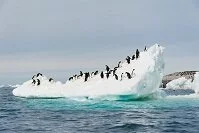Geography, Weather, & Wildlife of Antarctica
Geography

Mountains
Antarctica is located on and surrounding the south pole. It is an inhospitable island (with smaller islands off its coast) that is not governed by any particular country, but instead by a treaty. The island is surrounded by what is often times referred to as the Southern or Antarctic Ocean, but many don't recognize this as a distinct ocean and claim the island is surrounded by the Atlantic, Pacific, and Indian Oceans. It has no land borders; its closest neighbors are New Zealand (Australasia) and Argentina & Chile (South America), although there are several island territories that are closer to Antarctica. These island territories are governed by the United Kingdom, France, Australia, New Zealand, Norway, and South Africa.

Penguins on an iceberg
Geographically, Antarctica is a landmass with odd shapes as the glaciated surface has altered the continent's original features. There are some mountains near the Antarctic Peninsula (South America side) and along the coast near the Ross Sea (New Zealand side). The rest of the continent consists of plateaus and sweeping valleys and lowlands, but these will not be seen as nearly the entire continent is under an ice sheet, which can be up to 10,000 feet (3,000 meters) deep.